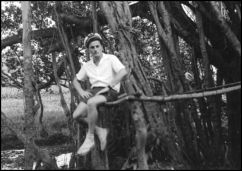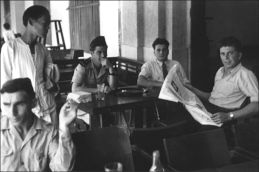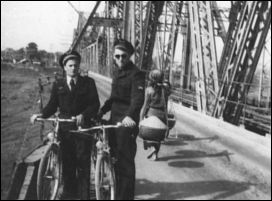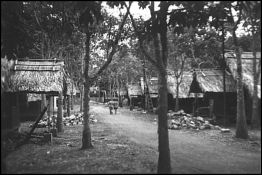|
Indochina 1949-1951
The Indochina war broke out in 1945 and escalated quickly. More troops were sent year after year. The 5th Wing
based in Sidi-Ahmed (Bizerte) was assigned for a one year tour of duty in south-east Asia. But unlike the previous
unit who had to use the equipment already there, the 5th was taking their own planes with them. So the wing would
take their American P-63 Kingcobra. The support unit made of mechanics of various trades was constituted. Strangely,
one member from the administration office was assigned to the unit. It was the technical supply-accountant which
happen to be me ! Thankfully a lot my mechanics buddies from El-Aouina were part of the unit so we had a tight
group. All personnels sent to Indochina were career soldier although we had a few draftees who were lured either
by the cash bonus or the search for adventure. Before shipping out, I sold my side-car to the first guy with a
descent offer. The entire 5th wing (Squadrons 1/5 Vendee and 2/5 Ile de France) and its auxiliary units gathered
in Sid-Ahmed before boarding for Saigon. The S/S Champollion would ferry the personnel while the aircraft carrier
Dixmude would handle the Kingcobras already partially disassembled and crated. We got on the way on June 30, 1949
for a long cruise with layovers in Port Said (entrance of the Suez canal), Djibouti, Aden, Colombo (Ceylon), Singapore
et finally Saigon after a 100 km trip up the Saigon river. Life on board was new for most of us if you exclude
the short hop we took to cross the Mediterranean. Except for the officers who had 1st class quarters, us non-Comm
and troop were stuck below deck in the cargo space with rudimentary accommodations: a few benches and tables and
hooks to setup our hammock for the night. No comfort what-so-ever, just a few sinks for the morning wash-up.
We were in July so the weather was getting hotter as we got closer to Egypt. From the very first day, I found it
difficult to sleep below deck because of the heat and smell. I went in search for a better place. The emergency
canoes located on the bridge turned out to be the perfect spot. Since they were covered, I was able to spend my
nights very comfortably. Actually, a few of my buddies did the same. The only drawback was to make sure that we
wouldn't get caught by the crew. Since they we washing the deck early in the morning, we had to sneak back in at
dawn.
We were able to go on shore during some of the layovers. We had 10 hours in the evening in Djibouti, a day in Colombo
(Ceylon at the time but now known as Sri Lanka). The 1st and 2nd class passengers had the opportunity to come ashore
in Singapore.
The sea had been calm for the first leg of the trip but everything changed once we were in the Indian Ocean. It
was the summer monsoon and we were met by big storms and torrential rain. We were able to overcome being sea-sick
thanks to a bunch of characters who endlessly entertained us. I've always been amazed how much a few distractions
could relieve the sickness! A sigh of relief could be heard through out the ship when we finally reached Cap St
Jacques at the mouth of the Saigon river. We dock in the Saigon harbor and came ashore under heavy rain and suffocating
heat.
In spite of the fact that we were accustomed to the North African lifestyle already different from home, we now
had to adjust to another life. Saigon was in the south and we were July 22nd so it was summer: rain and intense
heat. After the usual landing inspection, we were trucked to the Tan-Son-Nhut airbase on the north side of town.
We were housed in barracks nicknamed Fillod (they were manufactured by the Fillod company in St Amour). Nights
had to be spent under the protective cover of mosquito nets listening to the deafening concert of the toads!.
It took several days before I could get ride of the rocking feeling from the ship on which we had spent 3 weeks.
Our first few days were spent unloading the equipment from the Champollion and Dixmude. We had to handle ammunition
crates and load them on those tall and narrow English made Trucks. The planes, still in crates, were loaded on
trailers.
Both squadrons were reinforcements and were in Saigon only until they were operational. Once the planes were in
flying order, they would move north. The 1/5 was ready first and left Saigon for Hanoi (Gialam) in September. Our
auxiliary unit had to remain until the departure of the second group. During the four months we spend in Tan-Son-Nhut,
we were unable to go site seeing. Even simple leaves to go into town were sparse for, they said, safety reasons.
Regardless, we used the little free time we had to rest and catch up on sleep. When the last planes and personnel
of the 2/5 made their way north, our group (40 strong) started to get ready to move out. Instead of Gia-Lam, our
next home was going to be Bach-Mai (still near Hanoi though). We also were assigned an official title. Our unit
was the Park 1/482 detached to Bach Mai (the headquarter of the park 482 was in Bien-Hoa). But instead of being
flow to our new location like the rest of the wing, it was once again by boat that we made our way. The ship, the
S.S Esperance (Hope in French) had a name full of promises. But all it was really, was a coal cargo ship with enough
room to qualify as a troop transport. I believe he was ferrying coal from the north and picked up troop and supplies
that needed to move from the south. Our trip that should have taken a day or two lasted 11 days! Slowly making
its way along the coast with a three-day stopover in Tourane (although we were not allowed off the boat). During
this journey, we did everything possible to keep ourselves busy and make time go by quicker. Our unit was the only
one on board and the crew was all civilian and mostly Vietnamese. So discipline was lax but food was rather poor.
We unloaded in Haiphong and made the last leg of the trip by train.
Weather in Indochina is very different from north to south. We arrived in September 49 at the beginning of winter
which is a bit like the one in France, cold with frequent rain or drizzle and temps in the 10-20º C (14-68°
F) maximum. On the other hand, the south was in the dry season with temps in the mid 20s to the 30s and sometimes
higher.
Our tour of duty was supposed to be for one year unlike the Colonial tour that lasts two. However, we stayed for
18 months.
Our arrival was without celebration. Service personnel in Indochina really lived for the day of their return. Only
flying personnel were really involved in military operations. Even the ground crews who were busy with plane maintenance
to contend with had nothing else to do. The only military activity around was the base protection against the Viets.
We were pleasantly surprised to be housed outside of the base. Although we were close by, we were none-the-less
outside of the guarded perimeter. So we were armed with a machine gun each. It was recommended to sleep with it,
not only to keep it handy but also to prevent having it stolen by a night intruder. The Viets were known to be
able to sneak everywhere at night. One night as we were sleeping peacefully, they infiltrated our perimeter using
tunnels they had dug without anybody noticing. They got close to some planes and succeeded in blowing up a dozen
JU-52 by planting mines near them and detonate them as they retreated. Since our duty was to guard our quarter,
we were made aware of the result the next day.
From this point on, our off-site quarters became a possible target.
So we moved into barracks located inside the base perimeter. Security was tightened as well.
On Saturdays afternoon and Sundays, it was relatively easy to go downtown. However, transportation was sparse.
Bicycles and tricycles are very common in the north. There was a bicycle factory near Hanoi. With some friends,
we went there and each of us acquired a bike. From this point on, we had more freedom to go into town et even visit
our buddies at the 5th wing based out of Giam-Lam field by going across town and crossing the red river on the
Doumer bridge (Eiffel design). In the spring, we enjoyed going into town (during the day only) and go shopping
Rue de la Soie (Silk street) or any other street with their own specialty, hang out by the little lake in the center
of town. There was 2.5 miles between the base and the center of town and the terrain is flat, so this was an easy
ride. Other sources of entertainment were rare. There wasn't even a theater on the base. There was a specialty
house 300 feet from the base entrance. Civilians were running it but under the army's supervision. All branches
of the service attended this place, from the foreign legion to regular army, airforce and navy. The locals on the
other hand rarely set foot in this place.
My work consisted of the technical equipment accounting. It was neither glorious nor fascinating. But the friendship
that existed among us was strong and made up for the frustration of being far from home. We had a number of married
guys, some with children and this was especially hard for them, more so than for singles.
I acquired a record player and some hard to come by records of French artists. But it wasn't long before my buddies
got bored to listen to the same tunes over and over. In the end, they started to buy new ones to expend our repertoire.
The favorite moment of the day was the morning meal. It wasn't too hot yet and our break was long enough that we
could make it to the mess for a real meal "a la carte". We could choose a whole roasted chicken (for
two), cold cuts, cheese, bananas or pineapple with a good bottle of Bourgogne to top this off. Often time, we were
not hungry by lunchtime, either still full from our break or because the heat.
After a year spent in Indochina, we started to hope that our tour was near the end. But we had to come to the realization
that the one-year tour model did not really fit our profile. Even for the non-support units, it was decided that
the time spent re-assembling the planes would not be accounted for. Seeing that the situation was getting worse,
headquarter didn't seem ready to let us go. In December 1950, the army had already evacuated most isolated posts
in the northern part of the country. All the units that could be spared moved south. Our unit moved to Bien Hoa
where the Parc 482 we depended from was stationed. This time we made the trip in a C-47 Dakota. At that time, Bien
Hoa (30 km for Saigon) was a small base without any fighting unit stationed. It later became a large US and South
Vietnamese airbase. Although we were reunited with our primary unit, our group remained together and was kept apart.
That was fine, as our main concern was our pending return.
We were housed in some very exotic looking huts without any facilities. Since we weren't too busy, we had plenty
of time for site seeing or go into the nearby town. This charming community had not yet been damaged by the war.
After two months of this life, the news of our return home came. We moved to Saigon to have our return papers issued.
Most of us used this time to hunt for souvenirs and gifts to bring home if that hadn't been taken care of already.
In my case, shopping was take care of quickly as we were not accustomed to bringing souvenirs. The trunks were
packed and made ready to ship home via boat while we were flying back.
On February 7th 1951, we boarded a DC-4 Skymaster heading for France. After multiple layovers, we landed at Paris-Orly
on the 9th. Having left Saigon during the dry and hot season, we landed in the middle of winter wearing only light
civilian clothes. Since we had layovers in foreign countries, wearing our uniform had been forbidden. For most
of us, it had been two years since we had seen French soil, as we didn't get a leave prior to our departure from
Tunisia. After all these months of intense camaraderie, emotions were high as we parted company. A friend who was
getting married in Pierre-de-Bresse and I took the train together. On the way down, we meet a journalist from Radio
Luxembourg. He didn't miss an opportunity to interview us at length on the war in Indochina. At that time, the
war was so far away, most people didn't care about it. None-the-less, the left wing (mostly communists) was very
vocal in their opposition to this conflict, especially the troop deployment. In spite of this opposition, it took
another three years, the Dien-Bien-Phu tragedy and the Geneva accords to put an end to it.
A
special chapter is devoted to the French Air Forces in the war in
Indochina - 1939 to 1954
|
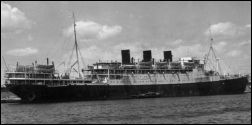
The S/S Champollion which took me from Bizerte to Saigon , 06/1949 - 07/22/1949
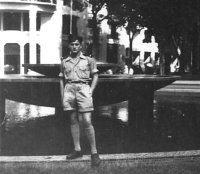
Saigon. First visit of the town.
|


